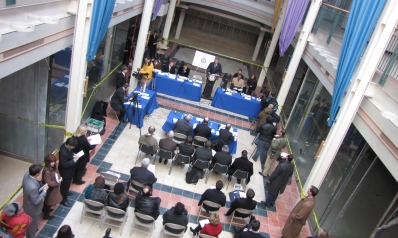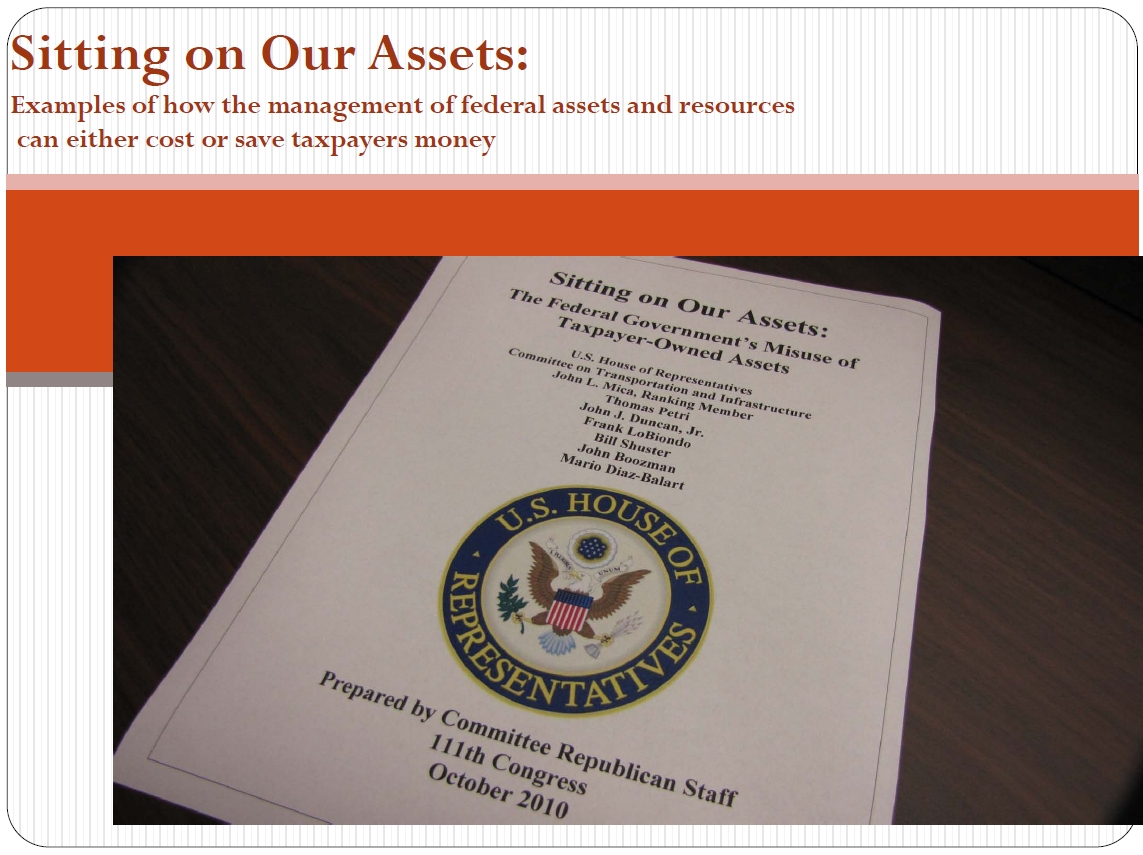Sitting On Our Assets
In order to cut federal spending, eliminate waste, and do more with less, the government must stop sitting on its assets. A report prepared by the Transportation and Infrastructure Committee's Republican staff identifies billions of dollars in potential savings to the taxpayer through improved management of federal assets and the elimination of waste in agencies and programs under the Committee’s jurisdiction.
In the 112th Congress, the Committee is using this report, entitled "Sitting On Our Assets: The Federal Government's Misuse of Taxpayer-Owned Assets," as a blueprint for saving taxpayers money and improving government programs. For example, in order to address the General Services Administration's wasteful mismanagment of federally-owned properties highlighted in the Sitting On Our Assets report and save billions of dollars for taxpayers, Members of the Committee introduced the Civilian Property Realignment Act in the 112th Congress.
Click here to read “Sitting on Our Assets: The Federal Government’s Misuse of Taxpayer-Owned Assets.”
Click here for the press release announcing the report.
 |
| February 10, 2011: Committee hearing on how underused and vacant federal buildings continue to waste taxpayers' money. |
Committee hearings and information:
- August 17, 2012: While Judges Attend Conference in Maui, Denham Leads Subcommittee Hearing on GSA Plans to Waste $400 Million on Unnecessary Los Angeles Courthouse
- Hearing information: LA Courthouse: GSA’s Plan to Spend $400 Million to Create Vacant Space
- August 6, 2012: Mica Takes GSA Investigation to Florida
- Hearing information: Sitting on Our Assets: The Vacant Federal Courthouse in Miami
- August 2, 2012: Congressional Hearing in Empty Miami, FL Federal Building
- June 19, 2012: Empty Federal Building Sits Idle for Over a Decade
- Hearing information: Sitting on Our Assets: The Georgetown Heating Plant
- June 15, 2012: Mica & Denham to Hold Hearing at Vacant Federal Building Near Georgetown Waterfront
- March 22, 2012: Members at Congressional Hearing in Empty Federal Building Fault Government for Sitting on Its Assets
- February 9, 2012: One Year Later: Still Sitting on Our Assets
- Press Release: Federal Government Finally Stops Sitting on Its Assets
- November 4, 2011: A Review and Analysis of the Proposed $400 Million Los Angeles, California Federal Courthouse Project
- Press Release: L.A. Courthouse Project Unnecessary According to Government Accountability Office
- July 6, 2011: The Securities and Exchange Commission's $500 Million Fleecing of America: Part Two
- Press Release: Denham Holds Hearing Targeting Wasteful $500 Million SEC Lease
- May 12, 2011: How to Stop Sitting on Our Assets: A Review of the Civilian Property Realignment Act
- Press Release: Denham Civilian BRAC Proposal Receives Broad Support
- April 6, 2011: Can a Civilian BRAC Commission Consolidate Federal Office Space and Save Taxpayers Billions?
- Press Release: Administration Agrees to Denham Principles for Civilian BRAC Commission to Save Billions of Taxpayer Dollars
- March 10, 2011: Cutting Spending and Consolidating Federal Office Space: GSA's Capital Investment and Leasing Program
- Press Release: Denham Presses Agency for Information on Wasteful Federal Properties
- March 4, 2011: Representative Denham Sends Letter to GSA Commissioner Requesting Complete Lists of Properties
- February 17, 2011: Sitting on our Assets: Rehabilitating and Improving our Nation's Rail Infrastructure
- Mica & Shuster statements from the hearing
- February 16, 2011: Taxpayers Save Hundreds of Millions of Dollars with FTC-National Gallery of Art Measures
- February 15, 2011: Accelerating the Project Delivery Process: Eliminating Bureaucratic Red Tape and Making Every Dollar Count
- February 10, 2011: Sitting on Our Assets: Cutting Spending and Private Redevelopment of Underperforming Buildings
- Mica & Denham statements from the hearing
- January 27, 2011: Developing True High-Speed Rail to the Northeast Corridor: Stop Sitting on Our Federal Assets
- Mica & Shuster statements from the hearing
Summary of "Sitting On Our Assets"
The Sitting On Our Assets report proposes cost savings and better utilization of government-owned resources across the entire jurisdiction of the Committee and its six subcommittees.
The U.S. government is the nation’s largest asset holder. It manages 896,000 buildings and structures with a total area of 3.29 billion square feet and more than 41 million acres of land. The General Services Administration, which acts as the federal government’s landlord, owns or leases 9,600 assets and maintains an inventory of more than 362 million square feet of space.
The Department of Transportation owns or leases approximately 69,500 real property assets – including land, buildings, and structures. There are more than 4 million miles of public roads in the United States. Amtrak, heavily subsidized by taxpayers, maintains over $17 billion dollars worth of infrastructure assets throughout its national rail passenger system.
There are approximately 1,700 miles of levees, 650 dams and 383 major lakes and reservoirs, 12,000 miles of commercial inland channels, and 75 hydropower generating facilities all owned by the federal government. The U.S. government also owns waterways leading to 926 coastal, Great Lakes, and inland harbors and 241 individual lock chambers at 195 sites nationwide.
“Sitting on Our Assets” focuses on improving asset management and reducing government waste, including in the following areas:
- The management of federal real estate and property under the General Services Administration
- Amtrak’s squandering the potential development of high-speed rail in the Northeast Corridor
- The Federal Aviation Administration’s management of air traffic control facilities
- Utilizing innovative financing alternatives, including well-defined private sector participation, for infrastructure projects
- Expediting the project approval process for infrastructure projects
- Streamlining reviews of Army Corps of Engineers civil works projects and reducing costs of project permitting
- Reducing waste in the Federal Emergency Management Agency’s emergency housing program
- More effective, efficient deployment of baggage screening equipment at airports
- Improving management of Tennessee Valley Authority assets and charge card program
- Operation of a leased training center for the National Transportation Safety Board
- Determining the future of a Coast Guard icebreaker fleet
 |
 |
|
| Sitting on Our Assets: A slideshow |




